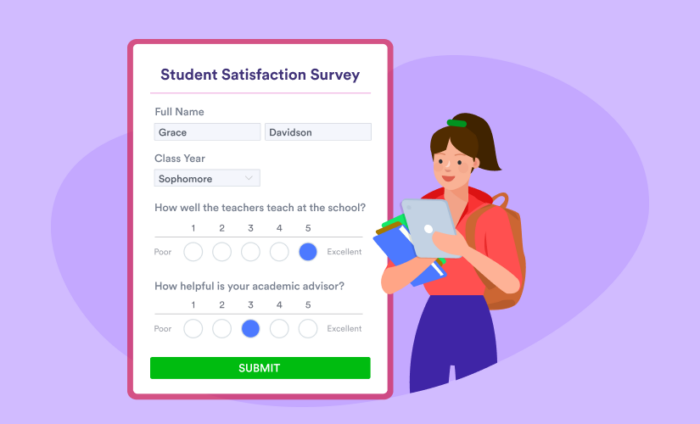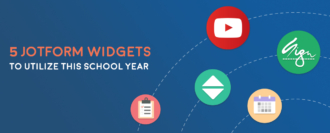The word “research” can mean different things to different people. In terms of education, it can refer to anything from a sixth grader taking a poll to see if their fellow students like the cafeteria food to a tenured academic conducting an empirical study that will inform a published paper.
Research is formal, informal, simple, complicated, and everything in between. It’s how we gain knowledge that informs new perspectives, confirms (or disproves) assumptions, and answers questions that lead to discovery.
Typically, when students and educators need to conduct research, easy-to-use and inexpensive survey software is the solution. The kind of online research they conduct requires flexibility. This means that survey features need enough horsepower to manage new requirements, while making it easy to get the most out of a given survey tool and features.
In this post, we’ll explore how your survey tools should match the type of research you’re performing, the top survey features today’s students and educators are using, and how Jotform caters to students and their research requirements.
The flexibility of your survey software should fit your research type
First off, it’s critical to define the goal(s) of your research. Students and educators should be able to answer the question, “What are the expected results of my survey?”
That answer will point you in the right direction when it comes to the kind of research you need to conduct. There are three types of survey research that will help you achieve your objective: descriptive, exploratory, and causal.
- Descriptive research collects quantifiable data that provides the statistics to back up your conclusion. For example, say you want to describe the feelings grade school students have about heading back into the classroom after a period of distance learning. A good surveying tactic to yield this data is sending groups of multiple-choice questions over a period of time to chart the change in opinions.
- Exploratory research is a bit more free form. It explores a given situation or set of circumstances to gain contextual information that helps define issues and describe a problem. An example of this type of survey might be asking fellow university students an open-ended three-question survey centered on diversity and inclusion on campus. By allowing students to write opinions in their own words, you can discover underlying factors that may be worth discussion and prioritization.
- Causal research is exactly what it sounds like; it tests the degree of cause-and-effect relationships (i.e., Does x cause y?). While straightforward in theory, causal research also deals with quantitative data, so your survey will need to be fairly complex to establish potential causation. For instance, the purpose of your survey could be to understand if the local high school should change its cafeteria menu. At a base level, the question you’re trying to answer may be “Will a better menu result in happier, healthier kids?” Because your hypothesis may be that it will.
When creating surveys, it’s a good idea to list your research needs first, as they may dictate the feature set of the tool you ultimately use. If you’re sending multiple surveys a month to hundreds of people, make sure the tool you use doesn’t limit the number of responses you can receive. Even after factoring in an average response rate, such limits could inhibit the work you need to do.
Now let’s explore how students and educators are getting the most out of Jotform’s survey features.
The survey product features education customers use
If the education community could design a best-case scenario survey builder, it would have the feature flexibility as well as customization and reporting functionality to ensure you get the information you’re after but also the ease of use, cost efficiency, and support needed for a diverse group of users.
Jotform’s survey tool exceeds that requirement, giving our customers exactly what they need to perform their tasks successfully. Here’s a closer look at the features our education customers favor for survey research.
Feature no. 1: CONDITIONAL AND SKIP LOGIC
What benefit does it offer? Conditional logic allows customers to tailor their survey to individual users, giving their research a quantitative edge. The education community employs conditional logic to show or hide fields based on responses, use field responses to calculate values, require or disable fields, and more. As a result, they can craft surveys that gather the type of information causal and descriptive research call for.
Jotform has been a valuable resource to our school for many years. The flexibility that Jotform provides with conditional logic allows for a really advanced application. I haven’t seen this in any other form tool.
Lynda Abel, Website Marketing Manager, Cannon SchoolFeature no. 2: CUSTOMIZABLE QUESTION TYPES
What benefit does this offer? When conducting surveys, it’s important to have flexibility in the types of questions you can use. Multiple-choice, Likert scale, and closed- and open-ended questions are minimum expectations. Our education users extend those features with shuffle options (to randomize the order of questions), hover text, entry validation and limits, default selections, and more.
There are additional customizations based on the survey field selected. Altogether, they give our customers best-in-class flexibility to get the data they seek in the most efficient way.
We use Jotform to survey the schools we work with throughout the world to get a better sense of the schools before we meet with them and as a communication method with current Ph.D. scholars we help support through surveys. Jotform allows for easy customization and distribution of the forms.
Shyan Xiong, Administrative staff, ScholarLeaders InternationalFeature no. 3: DISTRIBUTION METHODS
What benefit does it offer? Whether a student, faculty member, administrator, or web manager, many survey users need flexibility in the way they distribute surveys. Our customers embed their surveys in websites and blogs, share them via social media, email them, distribute them through third-party partner sites, and even create their own apps to share them with others. This helps them be more productive and meet their users where they are.
Jotform is easy to use and adjust to our needs when surveying students, faculty, staff, and community members. I can easily provide access to results, create reports, and even share submissions live on our website.
Meghan Keen, Director of Marketing & Public Relations, Strategic Communications, Mid Michigan CollegeFeature no. 4: MOBILE APP
What benefit does it offer? Mobility gives our education community the flexibility to create, receive, and communicate about surveys remotely or on the go. Not only does this improve speed and productivity, but users can access surveys offline too. They can also customize the automatic notifications they receive through the Jotform app when users submit their surveys.
Feature no. 5: REPORT BUILDER
What benefit does it offer? Students and educators benefit from real-time reporting and access to results. Thanks to the seamless connection between Jotform’s surveys and our Report Builder, they can create and customize reports of their survey results to share with peers, coworkers, and administrators. Our all-in-one platform also includes a workspace, a PDF converter, and approvals workflow solutions.
Jotform has single handedly changed the culture, efficiency, and productivity of our department. We use it for everything from event scheduling to polls and more. We love the easy-to-use interface, and our end users (students and faculty) find it very user-friendly.
I love being able to use Jotform to gather large amounts of data and then sort it however I see fit. Our department head loves data and loves to see charts, graphs, etc., that show where our strengths and weaknesses are in terms of institutional engagement.
user in the Department of English at Carnegie Mellon UniversityFeature no. 6: DATA SECURITY
What benefit does it offer? Data security is more a feature our users enjoy than something they have to actively employ. We protect data with a 256-bit SSL connection, GDPR compliance, CCPA compliance, and an option to encrypt surveys to keep the data completely private.
With Jotform, students can collect unlimited surveys
Our feature-rich and easy-to-use survey tools are great for the education community. And now we’re making it even easier to conduct surveys with Jotform’s Student Survey Program.
This program allows students to collect unlimited survey responses through their online surveys, gathering all the information they need to complete their projects — without breaking the bank.
The program is available to any student currently enrolled in a school, college, or university. As long as you have a valid student ID and .edu email address, you’ll be able to collect as many survey submissions as you like. Students can apply here; we’ll review each application and respond as quickly as possible.
For those within the greater education community who need to facilitate surveys regularly, make your job easier with more than 30 customizable survey templates. It’s as simple as using our drag-and-drop Form Builder to add multiple-choice or Likert scale fields, upload images and logos, including electronic signature and appointment fields, and more.
As mentioned earlier, you can convert survey data into reports to present an analysis of your data and gain new insights, all while easily managing and storing data in a table. Or if you prefer, automatically store survey feedback in your other accounts by syncing submissions to over 100 apps — including Google Drive and Dropbox.
The ability to organize forms in folders keeps things clean, and the integration with Google Sheets allows for sharing with other departments that need to collect and analyze submission data. Beyond all of that, the level of customer service we’ve received from Jotform is outstanding!
Ross Williams, Web Designer at a private university
Students and educators have been conducting educational research with Jotform for over a decade. Now it’s easier than ever.













































































































Send Comment: